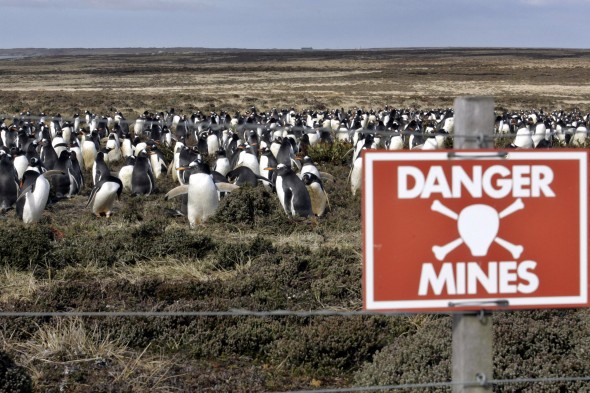Penguins of Mine
In December of 1981, General Leopoldo Galtieri took control of the junta which, at the time, ruled Argentina. But Galtieri and his government were hardly popular — the Argentine economy was failing and the junta was facing many accusations of human rights abuses. Galtieri was likely to be shortly ousted, but he had an idea to rally the nation behind him — start a war. Specifically, Galtieri decided to forcefully claim sovereignty over the Falkland Islands, a sparsely-populated archipelago in the South Atlantic Ocean. Great Britain also claimed the island despite their proximity to Argentina and despite generations of Argentine objection to that claim.
On April 2, 1982, Argentina invaded the Falklands, hoping to claim the area once and for all. Galtieri expected that the United Kingdom would let this invasion go unanswered — the Falklands are, themselves, pretty unimportant except for where ego or national pride is concerned. That assumption proved wrong. Margaret Thatcher, then the Prime Minister of the United Kingdom, decided to take the invasion as an opportunity to show her nation’s intolerance for dictators who threaten it. The UK fought back and, for ten weeks in 1982, the two nations were at war. The British prevailed, and since then, the UK has controlled the Falklands without much objection from the world (not that Argentina really likes it).
But since then, many of the beaches of the Falklands have remained uninhabited. The reason why? Landmines. During the war, Argentine forces left roughly 20,000 of them behind as they took land, impeding the British from retaking the areas. While there are some efforts to remove the mines, by and large, the solution to the mines is much more simple: fence off those areas and put up warning signs, as seen below.

And of course, people stay away. Which is great for the Falklands’ penguin population.
A few hundred years ago, per many estimates, 10 million penguins lived on the Falklands. But in the mid-1800s, the whaling industry in the region needed some way of rendering whale blubber into whale oil, and as QI notes, that requires a lot of heat. The Falkland Islands doesn’t have a lot of trees or other obvious ways to keep a fire going, so the whalers turned to the docile and fatty penguins, using them a fuel for their blubber-rending operations. The penguin population cratered, falling by as much as 95%.
But 100 years or so later, the mines of the Falklands War provided an accidental sanctuary for the penguins. First, they kept the people away. But more importantly, the land mines of that era were triggered by pressure applied to them from above — that is, if a person were to step on one, the mine would explode. Luckily for the penguins they’re light of foot — so light, that they don’t set off the mines. So while people need to beware of the mines, as seen below, penguins don’t.

In the 30-plus years since, the penguin population on the Falklands — now protected from us humans — has thrived, doubling to roughly 1 million.
 Bonus Fact: At first glance, penguins seem to have short, stubby legs which lack knees. But if you look at a penguin skeleton — here are some pictures (and they’re kind of creepy). you’ll see that they have a human-like bone structure including a pair of knees. Their upper legs are hidden beneath their feathers.
Bonus Fact: At first glance, penguins seem to have short, stubby legs which lack knees. But if you look at a penguin skeleton — here are some pictures (and they’re kind of creepy). you’ll see that they have a human-like bone structure including a pair of knees. Their upper legs are hidden beneath their feathers.
From the Archives: Pipe Nightmare: The bonus fact is about penguins. The main story is about something unrelated (but it stars a guy named Daniel Lewis).
Related: A pack of penguins.
